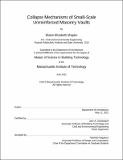Collapse mechanisms of small-scale unreinforced masonry vaults
Author(s)
Shapiro, Elaine Elizabeth
DownloadFull printable version (5.370Mb)
Other Contributors
Massachusetts Institute of Technology. Dept. of Architecture.
Advisor
John A. Ochsendorf.
Terms of use
Metadata
Show full item recordAbstract
The structural behavior of masonry arches under various forms of loading is well-studied; however, the three-dimensional behavior of barrel vaults and groin vaults is not as well understood. This thesis aims to address this problem by performing scale model testing of barrel and groin vaults as a complement to analytical solutions. The behavior of the model vaults are observed in four cases: (1) spreading supports, (2) vertical point loads applied at various locations of the vault's geometry, (3) point loads applied to an initially deformed vault, and (4) horizontal acceleration through tilting. In all cases, extensive experimental testing is carried out on a subset of three model vaults: two barrels and one groin vault, all with the same radius and thickness ratio but with different angles of embrace. High-speed cameras are used to capture the collapse mechanism of the vaults. The analyses include equilibrium methods executed through Excel and Matlab programs, publicly available online applets for arch stability, and hand calculations. The testing and analysis carried out in this thesis reveal several properties that can be used by engineers studying existing structures. First, a groin vault's spreading capacity is determined by the constituent barrel vault that is spreading. This simplifies the analysis to a two-dimensional problem. Second, the load capacity of a barrel vault is linearly proportional to the initial deformation in span. So, if a vault experiences a span increase that is 25% of the maximum it can withstand, its load capacity decreases by 25%. Nearly all vaults have experienced deformations due to settlement over time and will therefore respond differently to loading than a perfect vault which is the common starting point in analysis. This work can be applied to the understanding and maintenance of masonry vaults in service throughout the world.
Description
Thesis (S.M. in Building Technology)--Massachusetts Institute of Technology, Dept. of Architecture, 2012. This electronic version was submitted by the student author. The certified thesis is available in the Institute Archives and Special Collections. Cataloged from student submitted PDF version of thesis. Includes bibliographical references (p. 61-63).
Date issued
2012Department
Massachusetts Institute of Technology. Department of ArchitecturePublisher
Massachusetts Institute of Technology
Keywords
Architecture.